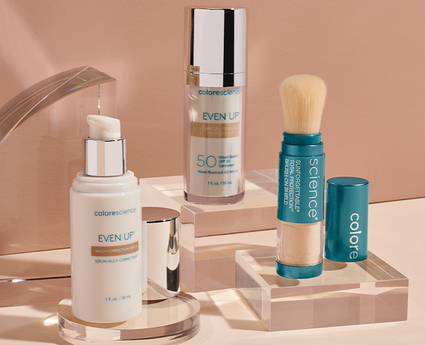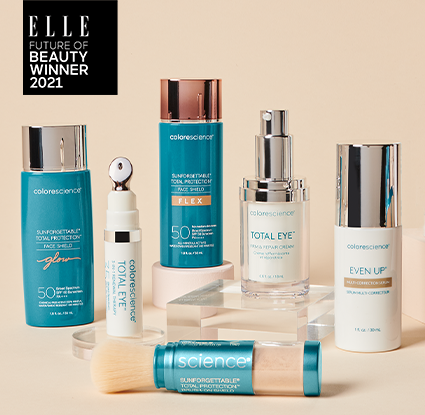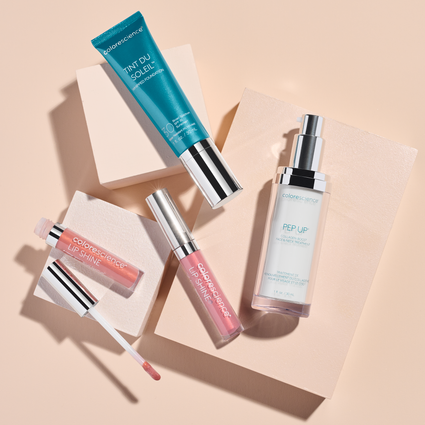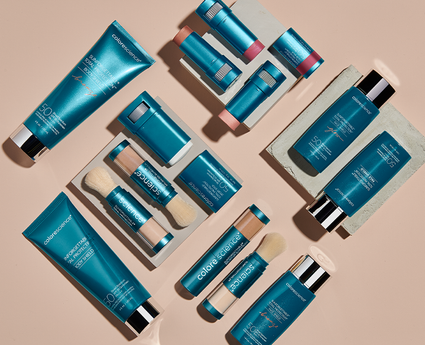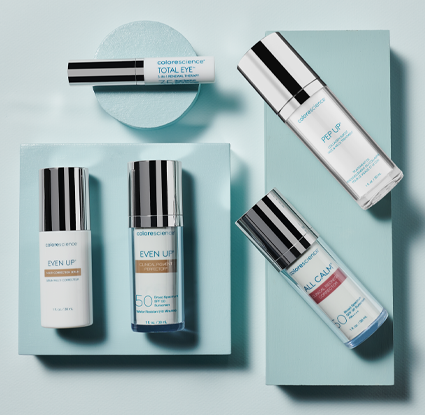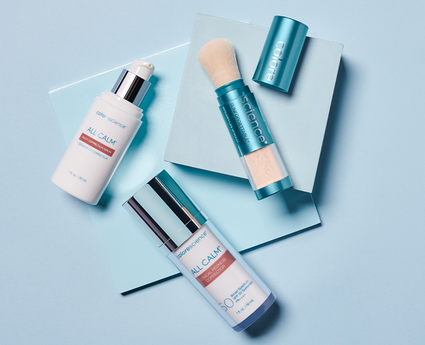Rosacea Makeup Routine: Makeup Tips to Help Cover Rosacea
Everyone loves having a pinch of red to their cheeks—why else would we keep stocking up on our favorite blushes? But when the redness becomes overwhelming and spreads past areas on your face that compliment you most, it can become more distressing than flattering. If you’re one of 16 million Americans that suffer from rosacea, you know good skin days and bad skin days all too well.
This chronic skin disorder primarily affects the face, but it can also spread to the ears, chest, and back. The unfortunate reality of rosacea is that it is unpredictable. Your skin might be frustrating on a day-to-day basis, but these beauty tips can help minimize the random, red flare-ups and provide the best makeup for rosacea secrets you need to know for picture-perfect concealing!
- Tip #1 - Understand your skin: What is rosacea?
- Tip #2 - Skincare first
- Tip #3 - Steer clear of irritants
- Tip #4 - Exfoliate with caution
- Tip #5 - Make the most of your makeup
- Tip #6 - Get glam the right way: How to apply foundation
Tip #1 - Understand your skin: What is rosacea?
Before panicking over a bout of facial redness, make sure you know exactly what you’re dealing with. There are four different types of rosacea:
-
Vascular rosacea
The most common subtype of rosacea. Characterized by persistent facial redness and visible blood vessels on the face, neck, and/or chest. Vascular (or erythematotelangiectatic) rosacea flare-ups are typically itchy and feel hot to the skin.
-
Inflammatory rosacea
Characterized by papules and pustules, or raised, pus-filled bumps, which flare up as quickly as they cool down, inflammatory (or papulopustular) rosacea is often associated with burning and stinging sensations.
-
Phymatous rosacea
Unlike other rosacea subtypes, Phymatous rosacea is characterized by a thickening texture of the skin and enlarged sebaceous glands that flourish on and around the nose. This type of rosacea is more common in men than in women.
-
Ocular rosacea
Ocular rosacea is centrally located in the eye area. Characterized by the typical itchiness and burning redness, Ocular rosacea may also cause swelling of the eyes and blurred vision.

Being able to care for, conceal, and select the best makeup for your rosacea relies on having a solid understanding of which subtype of rosacea your skin falls into. Those with inflammatory rosacea should look try to smoothen the texture of their skin, for example, while those with vascular rosacea might prioritize color correctors instead.
Tip #2 - Skincare first
The same way you had to regularly treat acne flare-ups during your pesky teenage years, the first step to caring for your rosacea is implementing a daily skincare routine. Proper skincare can make a noticeable difference in redness and even reduce the severity and frequency of episodes. Following this three-step routine on a daily basis can help make your skin look and feel amazing.
1. Wash your face twice a day
Squeezing in two daily face washes is a simple addition to your morning and nighttime routine. Dermatologists noticed that many patients with rosacea who failed to maintain a regular face washing routine frequently went to sleep with oils, bacteria, and dirt sitting on their skin. Allowing these harmful irritants to fester overnight can lead to increased flare-ups and worsen the overall redness. Your rosacea-friendly routine should include:
- A mild fragrance-free facial cleanser
- Gentle, circular-motioned application with your fingers
- A thorough rinse off with lukewarm water
- Patting your face dry with a clean cotton towel
2. Moisturize, moisturize, moisturize
Regardless of whether your rosacea makes your skin dry or oily, remembering to moisturize is an incredibly important piece to your skincare regimen. Like your cleansing routine, make sure you select a rosacea-friendly moisturizer. Our Colorescience All Calm Redness Corrector packs a 3-in-1 punch by correcting, protecting, and addressing the needs of your sensitive skin. Daily moisturization, and regular use of skin hydrating mists helps retain water and thus reduces the typical irritation that comes with inflammation.

3. Use your SPF
Ladies, we know it’s tough to hear, but the sun is not your friend. In fact, extended sun exposure can actually worsen your rosacea! But hope is not lost! The key to keeping cozy in the sunlight without worrying about your skin is to have protective SPF handy. Finding a sunscreen for your sensitive skin may be difficult, but it’s not impossible. Look for the following on sunscreen labels and avoid harsh chemicals:
- Zinc oxide and/or titanium dioxide
- Silicone – could be listed as cyclomethicone, orcyclomethicone, or dimethicone
- SPF 30 or higher
- Fragrance-free label (not necessarily unscented)
- Broad-spectrum sunscreen
Bonus: combine Step 3 and Step 2 – our All Calm Redness Corrector also includes SPF 50 protection.
Tip #3 - Steer clear of irritants
Be nice to your skin with calming products and creams, and by staying far away from products that could trigger a flare-up. Be on the lookout for any creams, sprays, or gels that contain the following ingredients:
- Sodium laurel sulfate
- Fragrance
- Peppermint
- Eucalyptus oil
- Camphor
- Urea
- Menthol
- Alcohol
Other potential irritants include witch hazel, astringent, and toner. All of these skincare ingredients can dry out your skin and turn your dream of a moisturized facial landscape into a nightmarish, scaly desert.
Tip #4 - Exfoliate with caution
Though you’d probably imagine that getting deep into your pores with a rosacea-friendly cleanser could solve your problem, exfoliation sometimes has the reverse effect. Rough scrubbing can further irritate your skin and, at times, trigger a flare-up when none was present.
Exfoliators are designed to scrub away the top layer of skin which can rejuvenate normal skin types and prevent blackheads or pimples from forming. For those with sensitive skin, or use makeup for sensitive skin, exfoliators can be just another irritant to your delicate complexion. Stick to gentle, natural cleansers to minimize the effects of rosacea.
In order to minimize flare-ups, watch out for the most common rosacea triggers known to wreak havoc on sensitive skin. Take a look at the table below to keep your rosy cheeks at bay.
Tip #5 - Make the most of your makeup
Finding the best makeup to cover rosacea is tough since most popular brands tend to market to standard skin types on the slightly oily to dry spectrum. Your sensitive skin deserves justice, and a little bit of research is the trick. By simply searching the web for specific color correctors and setting sprays that won’t irritate your rosacea, you can add a few key products to your beauty arsenal. Whether you’re going for daily natural looks or full glam faces, make sure these essentials are in your cart:
- Primer
- Tinted concealer
- Foundation
- Setting powder
- Blush or bronzer
Like always, verify that the products you’re purchasing are suitable makeup for rosacea skin.
While the first four items in your cart work to conceal the redness of your rosacea, you might want to replace some of that natural flush with a light blush.
Pro Tip: To find all the concealing makeup for rosacea you’ll need for a fresh face, consider our All Calm Corrective Kit for Redness. It comes stocked with our hydrating setting mist, Sunforgettable Brush-on Sunscreen, and All Calm Redness Corrector!

Tip #6 - Get glam the right way: How to apply foundation
Everyone’s makeup application is a little different. Some people put on their foundation first, or their powder absolutely last. Whatever routine you live by, make sure you’re getting glammed up with the highest quality coverage. Correctly applying your makeup to cover rosacea is equally dependent on the right products as the proper order.
1. Prime your skin
Before reaching for your concealer, you need to prime your face. Not only does a calming skin primer with SPF ensure that your makeup lasts all day and all night, but it also serves as a protective layer between your sensitive skin and additional makeup products.
2. Apply tinted concealer
In order to counteract the redness of your rosacea, you will need to apply a yellow or green tinted concealer. Use a large-sized concealer brush to cover all of your problem areas.
3. Dot on your foundation
Even with large problem areas, you’ll find that less is always more. When applying foundation, you want to avoid a cakey look while still covering the rosacea redness. Accomplish a full coverage look by applying dots of liquid foundation to your face with a good sized foundation brush.
4. Blend it
The key to a naturally blended face is a damp blender sponge. By using a bouncing or stippling motion rather than a counterproductive wiping motion, it’ll take less time to blend your foundation in with your color corrective concealer.
5. Set it
Though setting sprays seem to be the beauty industry’s favorite way to set various makeup looks, a setting powder does an amazing job—especially on makeup for rosacea skin types. Take a quality setting brush or a powder puff and, pat your rosacea-friendly powder into your target zones for a natural, matte finish.
6. Revive that face
Now that your face is looking clearer and more even than ever before, you might need to bring some dimension back to your complexion. Contour palettes, highlighters, bronzers, and blushes can all work to bring out the angles of your face. Apply sparingly to achieve the most natural look.
Conclusion
Rosacea skin can be a real pain to harness and keep under control, especially when flare-ups could happen on the flip of a dime. The first step to handling your sensitive skin like a pro is by maintaining your skin like a pro. Having a morning and night routine down-pat can reduce redness over time, and applying full coverage makeup can help you look and feel great when it matters most. Being kind to your skin has amazing results, all you need to do is begin!

